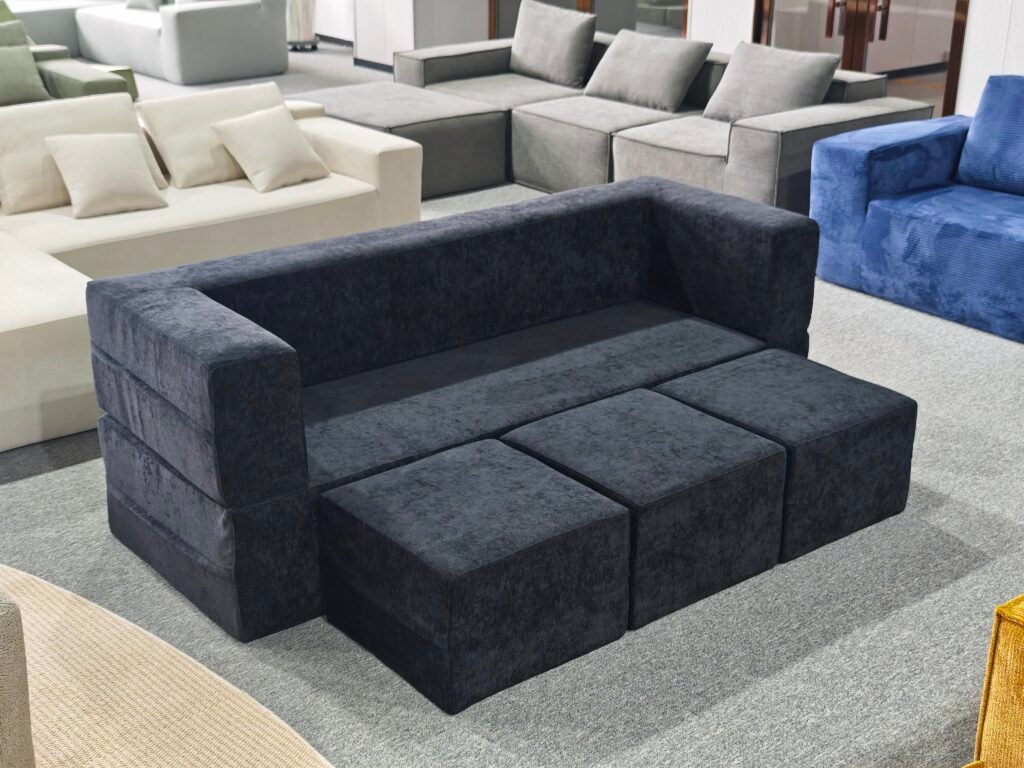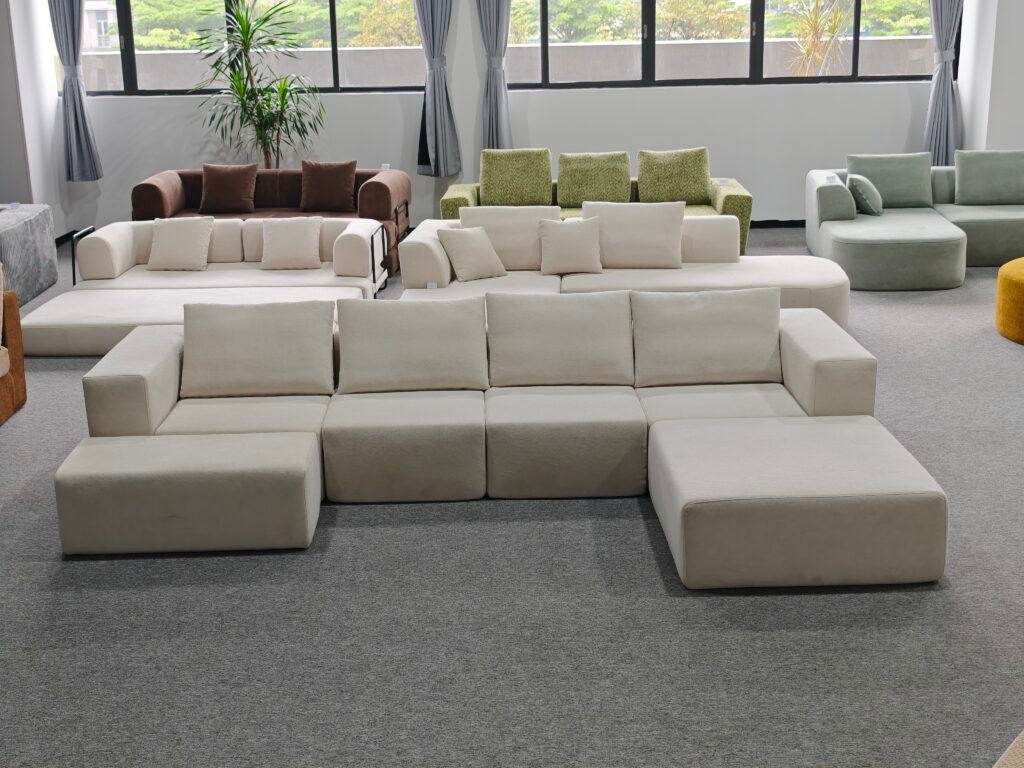In recent years, compressed sofas have become a popular trend in the furniture industry, especially for urban living and e-commerce distribution. These sofas are designed to be tightly compressed or vacuum-packed to reduce shipping volume, making transportation more cost-effective and convenient for consumers. However, one notable characteristic of most compressed sofas in the market is their predominant use of fabric upholstery rather than leather.
This article explores the reasons behind this industry preference, analyzing the technical, aesthetic, and practical factors that make fabric the superior choice for compressed sofas. By understanding these dynamics, furniture manufacturers, retailers, and consumers can better appreciate the innovation behind compressed sofas and make informed decisions.


The Nature of Compressed Sofas and Material Requirements
A compressed sofa undergoes a unique manufacturing and logistics process. After production, the sofa is compressed—often by vacuum packing or mechanical folding—to reduce its size by more than 70%. This compression allows for easier shipping, lower freight costs, and simpler handling at the consumer end.
However, this compression process places significant demands on the sofa’s materials, especially the upholstery fabric. The covering must endure:
- Repeated folding and unfolding without damage
- Resistance to permanent creases and wrinkles
- Elastic recovery to original shape
- Durability under mechanical stress
These requirements limit the types of materials that can be used effectively. While foam cores and frame materials can be engineered for compression, upholstery materials face more constraints.
Why Leather Is Not Suitable for Compressed Sofas
Leather, whether genuine or synthetic, has several inherent characteristics that make it unsuitable for compressed sofas:
Low Elasticity and Flexibility:
Leather is a natural or synthetic hide that lacks the stretch and recovery properties needed to withstand tight compression. When folded or compressed, leather can develop permanent creases or cracks, damaging its appearance and structural integrity. Unlike fabrics that can stretch and rebound, leather's rigidity makes it prone to deformation.
Susceptibility to Damage During Compression:
The compression process can cause leather to crease sharply, leading to cracking or peeling over time. This not only reduces the sofa’s lifespan but also diminishes its aesthetic appeal. Repairing leather damage is costly and often impractical.
Temperature Sensitivity:
Leather reacts to temperature and humidity changes, which can be exacerbated by the vacuum-sealed packaging environment. It may become stiff or brittle in cold conditions and sticky or soft in heat, further complicating compression handling.
Limited Design Flexibility:
Leather upholstery often requires more precise cutting and stitching to maintain its natural grain and appearance. This makes it difficult to accommodate the folding and compression techniques used in compressed sofas without compromising the finish.
Higher Cost and Weight:
Leather sofas generally cost more and weigh more than fabric sofas, increasing shipping costs and reducing the economic benefits of compression.
Because of these factors, most compressed sofa manufacturers avoid leather and instead opt for specially engineered fabrics.
Advantages of Fabric for Compressed Sofas
Fabric upholstery offers several advantages that align well with the demands of compressed sofas:
High Elasticity and Wrinkle Resistance:
Modern performance fabrics, such as polyester blends and microfiber, have excellent stretch and recovery capabilities. They can be compressed and folded repeatedly without permanent creasing or damage. Many are treated with wrinkle-resistant finishes to enhance durability.
Lightweight and Breathable:
Fabric materials are generally lighter than leather, reducing overall sofa weight and making compression and shipping more efficient. Breathable fabrics also help prevent moisture buildup inside packaging, reducing the risk of mold and odors.
Wide Variety of Designs and Textures:
Fabric upholstery comes in countless colors, patterns, and textures, allowing manufacturers to offer diverse styles that appeal to different consumer preferences. This flexibility is harder to achieve with leather, which has a more limited color palette and texture variation.
Cost-Effectiveness:
Fabric sofas typically have lower material and manufacturing costs, making compressed sofas more affordable for consumers. This cost advantage is crucial given the competitive pricing pressures in the compressed furniture market.
Comfort and Warmth:
Fabric sofas provide a softer, warmer seating experience, which many consumers prefer for everyday use. Unlike leather, which can feel cold in winter and sticky in summer, fabric maintains a more consistent and cozy temperature.


Sustainability and Innovation:
Many fabric manufacturers now produce eco-friendly and stain-resistant textiles that enhance sofa longevity and ease of maintenance. These innovations align well with compressed sofa production, where durability and customer satisfaction are paramount.
Table: Comparison Between Fabric and Leather for Compressed Sofas
| Feature | Fabric Upholstery | Leather Upholstery | Impact on Compressed Sofa Use |
|---|---|---|---|
| Elasticity & Flexibility | High; recovers well from compression | Low; prone to creasing and cracking | Fabric withstands compression better |
| Durability Under Compression | Excellent with wrinkle-resistant treatments | Poor; susceptible to permanent damage | Fabric preferred for repeated compression |
| Weight | Lightweight | Heavier | Fabric reduces shipping and handling costs |
| Breathability | High; prevents moisture buildup | Low; can trap heat and moisture | Fabric reduces odor and mold risk |
| Design Variety | Wide range of colors, patterns, textures | Limited colors and textures | Fabric offers more customization options |
| Comfort | Soft, warm, cozy | Firm initially, can be sticky or cold | Fabric preferred for everyday comfort |
| Maintenance | Stain-resistant options available | Easy to wipe but requires conditioning | Fabric easier to maintain post-compression |
| Cost | Generally more affordable | Higher cost | Fabric reduces overall product price |
| Environmental Impact | Increasingly eco-friendly options available | Leather production has higher environmental cost | Fabric aligns better with sustainability goals |
Industry Insights and Manufacturer Practices
Leading compressed sofa manufacturers, including Modular Sofas, emphasize the importance of fabric choice in product development. According to industry experts, genuine leather is rarely used in compressed sofas because it cannot meet the mechanical demands of compression packaging without compromising quality.
Instead, factories focus on high-performance fabrics engineered for compression durability. These fabrics undergo rigorous testing for wrinkle resistance, tensile strength, and abrasion resistance. Foam cores are paired with these fabrics to ensure the sofa regains its shape quickly and maintains comfort after unpacking.
Some manufacturers have also innovated by patenting unique compression-friendly fabric blends and finishes, expanding the design possibilities while ensuring functional reliability.
Consumer Preferences and Market Trends
Consumer feedback and market research reveal that buyers of compressed sofas prioritize comfort, durability, and affordability. Fabric sofas align well with these priorities, offering a cozy feel and diverse style options at competitive prices.
Additionally, the rise of online furniture sales and direct-to-consumer models has accelerated demand for compressed sofas that ship efficiently. Fabric upholstery’s compatibility with compression packaging supports this trend, enabling manufacturers to meet delivery expectations without sacrificing quality.
Challenges and Considerations in Fabric Use
While fabric offers many advantages, manufacturers must address potential challenges:
- Stain Susceptibility: Fabric can absorb spills more readily than leather, but modern stain-resistant treatments mitigate this issue.
- Cleaning and Maintenance: Fabric sofas require regular vacuuming and occasional professional cleaning, which consumers should be aware of.
- Wear and Tear: Lower-quality fabrics may pill or fade over time; hence, selecting premium performance fabrics is essential.
By carefully selecting and treating fabrics, manufacturers can overcome these challenges and deliver high-quality compressed sofas that satisfy customers.


The Future of Upholstery in Compressed Sofas
As technology advances, new fabric innovations continue to emerge. Smart textiles with enhanced durability, antimicrobial properties, and environmental sustainability are becoming standard in compressed sofa production.
At the same time, research into synthetic leather alternatives aims to combine leather’s aesthetic appeal with fabric’s flexibility, potentially opening new possibilities for compressed sofa upholstery.
Modular Sofas remains at the forefront of these developments, integrating cutting-edge materials and compression techniques to produce sofas that meet modern lifestyle demands.
If you are interested in exploring high-quality compressed sofas that combine innovative compression technology with carefully selected fabrics, please visit Modular Sofas to discover our latest collections and customization options.